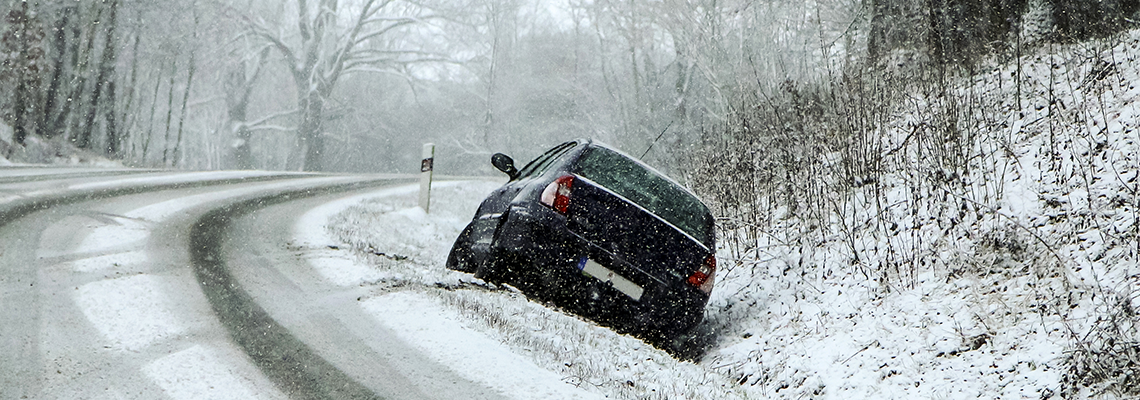
WHAT TO KNOW ABOUT
WINTER DRIVING ACCIDENTS
According to an analysis by the website Safewise, Idaho is the fourth most dangerous state in the nation for driving in the snow, with 0.6647 crashes per 100,000 drivers. Neighboring Wyoming came in worst at 1.5356 per 100,000.
The odds may seem long to be involved in an accident, but winter driving indeed requires extra caution, not only in how you drive but also in how you prepare your vehicle for the increased challenges.
If you are involved in a crash during the winter, insurance companies are known to use weather as a factor in evaluating claims for injuries and damages. Insurance companies are notorious for asserting that you didn’t take the precautions necessary and were thus negligent. The companies can use this to limit or deny your claim.
If you’ve been injured in a winter car crash in Boise, Meridian, Idaho, or anywhere in Ada or Canyon County, contact the Shep Law Group. Our car accident attorney has more than 15 years of experience helping others like you deal with insurance companies and obtain the just compensation deserved.
Idaho Insurance Laws: Assessing Liability
Idaho requires drivers to have auto insurance bodily liability coverage of $25,000 per person, and $50,000 per accident, which covers medical expenses for others injured through your fault. The law also requires $15,000 of property liability coverage for any damage you cause to someone else’s property, whether it is a car or something else. You can purchase higher limits on both.
Underinsured motorist (UM) and underinsured motorist (UIM) coverage is also a standard part of the coverage, though it can be opted out of by providing a written request.
Thus, if you’re in an auto accident in Idaho, in winter conditions or otherwise, you can make a claim against the at-fault driver’s insurance policy, or you can contact your insurance company, who will then seek a subrogation claim against the other party’s insurance.
If you are injured and your medical expenses exceed what the at-fault driver’s policy will cover (the basic cap is $25,000 per person), you can seek a personal injury lawsuit, or you can go to court immediately before dealing with any insurer.
How Fault Is Determined and Divided
However, under Idaho’s use of the principle of modified comparative negligence, your role – or your portion of the fault in the accident – will be used to assess damages recoverable.
For instance, if you’ve been rear-ended and suffered neck and back injuries, but while you were driving, one of your taillights was malfunctioning, you are 20 percent (or more or less) of the fault. Thus, if your court award is $50,000, you would receive only 80 percent of the total, or $40,000. If your fault rises above 50 percent, you cannot collect anything.
Insurance adjusters will use the same comparative standard when you file a claim. Adjusters will employ time-honored techniques to get you to say or admit something that is used to pin at least part of the fault on you. Thus, adjusters can lowball or even deny your settlement using comparative negligence standards.
Tips for Safe Winter Driving
Driving in the snow – or rain, or other hazardous winter conditions – requires extra caution on every driver’s part. The Idaho State Police have a complete web page devoted to “Driving Safely During Idaho Winters.”
The Idaho State Polices’ first bit of advice is to plan and figure your drive will take a lot longer than it would in spring or summer conditions. Thus, slow down – the police recommend half the posted speed limit -- and allow for more space between you and other vehicles. After all, even the newest and best-maintained vehicles are going to need extra time to stop in winter conditions.
Idaho does not mandate the use of chains on your tires for driving in snowy conditions. Some four-wheel-drive vehicles can transverse snowy roads with good traction, but two-wheel-drive vehicles must be handled cautiously. Buy winter tires or use chains to be better protected.
The police also recommend that you check your car’s mechanical conditions before winter sets in, as the cold can cause belts to break and batteries to go dead. The last thing you want is to be in the snow with an engine you can’t operate because a belt is out or a battery is dead.
Idaho law is clear, however, on maintaining clear visibility in your vehicle. Idaho Code 49-612(3) states: “No vehicle shall be operated when the windshield and/or windows of the vehicle are coated with ice, snow, sleet, or dust to the extent that the driver’s view ahead, or to the sides or rear of the vehicle is obstructed.”
Experienced Idaho Personal Injury Attorneys in Boise, Idaho
Using the principle of comparative negligence, insurance companies are going to use claims adjusters to blame you, so insurance companies can lowball or even deny your claim for personal injury in a car accident, in wintertime, or any other season. Wintertime provides extra fuel to claim you were driving too fast, following too closely, or otherwise not taking appropriate caution.
You don’t want to deal with insurance adjusters by yourself. Contact the Shep Law Group, and let our attorney handle the adjusters while you recover from your injuries. We can seek to advise you of when a personal injury lawsuit is justified.
We proudly handle clients in Boise, Meridian, Ada, or Canyon County, Idaho. Reach out to us as soon as the accident occurs, and let us take it from there.